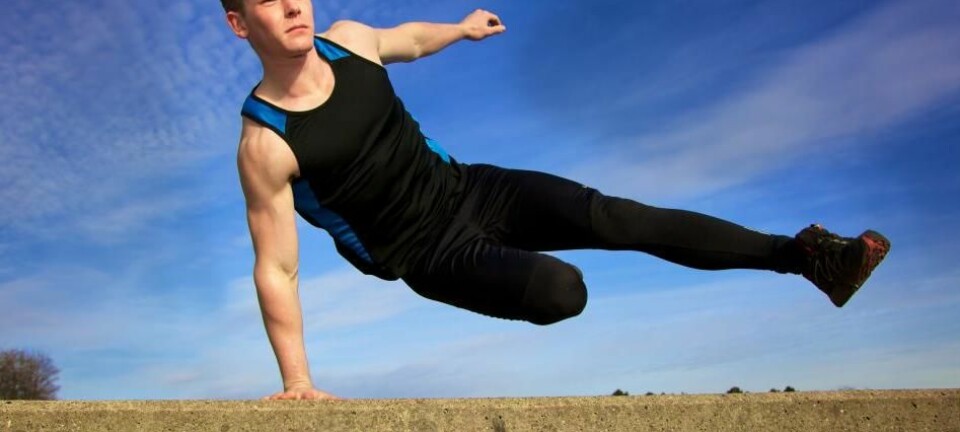
Test yourself: Are you addicted to exercise?
Danish researchers have developed a world first. It is a new method to spot exercise addiction among children and young adults.
Tempting shops, endless work, entertaining video games, binge eating, daily sex, or excessive exercise. Do you know how it feels to be addicted to your own behaviour? Research shows that we can become so satisfied with our own preferred activities, that we soon become addicted. It’s called a behavioural addiction and includes all types of activities.
The best known and most diagnostically recognised form of behaviour addiction is gambling, which can cost a fortune, wreck marriages, and cause people to lose their jobs.
New behavioural addictions emerge according to how societies develop, and we know that people who develop one form of behavioural addiction are likely to develop other forms in the future. For example, there appears to be a connection between excessive exercise and addiction to shopping.
Previous research has shown that young people have a higher risk of developing these types of dependencies than people who by virtue of their age live a quieter, more stable life.

We still do not yet understand the long term consequences among young people consumed by computer games or the fitness centre. But it looks as though behaviour-addicted young adults are more likely to develop psychological and social problems later in life.
Read More: Mice experiments explain how addiction changes our brains
How do we identify addiction in people so young?
It is therefore important to be able to identify adolescents at risk of developing such addictions. Previous research projects have developed and tested questionnaires to reveal gambling and computer game addictions among young adults. But even though exercise addiction has a clear age-related component (younger people are at higher risk), we still have no way to measure the prevalence of addictive behaviour among adolescents.
The most recognised questionnaire for exercise addiction among adults is the Exercise Addiction Inventory (EAI). It is based on six general symptoms and can be adapted to measure any activity.
Symptoms include acclimatisation (whereby you need to be increasingly active to experience the same kick), and withdrawal symptoms (whereby you feel restless and agitated if you do not exercise).
However, until now we have had no such survey for young adults and children, despite the fact that exercise dependency often appears during the teenage years.
Read More: How authorities can help children of drug addicts
Are you addicted to exercise?
Based on the adult version of the EAI, we have developed another questionnaire aimed at adolescents and distributed it to 471 young people in Denmark aged 11 to 20 years. We call it EAI-Y.
You can take the test yourself below. It was developed for adolescents and emerging adults, but it has many similarities to the adult questionnaire.
If you score between 24 and 30 points there is a high risk that you have developed an unhealthy relationship to training and exercise. In this case, exercise has control over your life and has a big influence on your self-worth and identity.
Since there is no diagnostic manual for exercise addiction, this test is the only tool we have to identify indications of a potentially harmful fitness regime.
It was developed in collaboration with one of the world’s leading researchers in behaviour addiction, Professor Mark Griffiths from Nottingham Trent University in the UK. He is the lead scientist behind the EAI and co-author on our new study, which documents and validates the EAI-Y. The new results are published in the Journal of Behavioural Addictions.
Read More: Videogame addiction linked to ADHD
How many adolescents are at risk?
In our study, we identified how many participants were at risk of developing an exercise addiction (EAI-Y score 24-30). We found that 4.0 per cent of school athletes, 8.7 per cent of fitness centre users, and 21 per cent of those with an eating disorder fell into this group.
An Italian study from 2011 discovered that 8.5 per cent of a group of students between 13 and 20 years old were at high risk of developing an exercise addiction, while another study from Russia and Spain found a 23 to 27 per cent risk.
The problem has not been studied in other age groups across cultures and sports disciplines. But the EAI-Y will make it possible to use the same instrument in future studies to identify those at high-risk of exercise dependency.
Read More: Fitness addicts get withdrawal symptoms just like alcoholics
Negative body image, harmful, or disturbing eating habits
Since the research field is new, we still do not know how much damage is caused by a short term exercise addiction that might last for just one year. But we have observed some worrying trends among young people that could potentially lead to overload and eating disorders.
Our study revealed that 64 per cent of young people with an exercise addiction continued to exercise despite feeling pain, and 97 per cent felt guilty when they didn’t train enough, compared to 32 per cent and 45 per cent of those who were not addicted to exercise. Of those who were addicted to exercise, 62 per cent reported reduced performance due to over training, compared to 22 per cent in the non-addicted group.
Finally, 74 per cent of addicts felt overweight, even though others viewed them as slim, and 74 per cent stated that food dominated (controlled) their lives. This compares to 40 per cent among the non-addicted group, and 27 per cent who reported symptoms of eating disorders.
Exercise addiction also appears to correlate with ignoring pain and injury, feelings of guilt when not exercising, and higher levels of body dissatisfaction and unhealthy eating habits.
Read More: Test yourself: Are you addicted to shopping?
Danish youth top the charts for “feeling fat”
A report from the World Health Organisation (WHO) showed that where I live, Denmark, kids aged 11 to 15 years are more concerned about weight loss than any other of the 41 European countries in the report.
Despite the fact that they were generally the slimmest, Danish youth scored highly when it came to “feeling fat.”
This is symptomatic of the fact that a negative body image and unhealthy weight loss behaviour (for example compulsive exercise and vomiting) appear to be a rising problem in western societies, which increase the risk of developing eating disorders.
Read More: The darker side of workouts
New study will map the prevalence of exercise addiction among young people
At a time when physical activity and weight gain represent big problems for public health authorities, spending resources on a small group of over active teenagers could seem less significant.
I’m often asked whether ‘lazy’ people might use the risk of exercise addiction as an argument to drop weekly exercise programs? It’s a possibility.
But this same argument can just as easily be applied to eating disorders: We shouldn’t diagnose anorexia as overweight people might use the risk of becoming pathologically underweight as an argument for continuing to overeat.
We should take care of our young people and a small group of them develop harmful a dependency on the kick they get from physical activity. First, we need to find these young people who exhibit the classic symptoms of addiction. Next, we need to offer help to them and their relatives.
We still do not have enough studies to know how we can prevent and treat exercise addiction. Let’s fill this gap and offer qualified help to these young people and vocalise how this condition makes people ill.
Exercise dependency does not just happen out of the blue. It occurs when young people are unhappy. They find a solution and trust in an exercise regime that gives them safety and control, but in the long-run, can destroy their health and quality of life.
A number of associations offer support to young people who are experiencing problems with over-exercise and eating. Such as Mindhelper and LMS in Denmark (websites in Danish). If you suspect that you have an addiction you should contact your local doctor.
---------------
Read this article in Danish at ForskerZonen, part of Videnskab.dk
Translated by: Catherine Jex








